Thessaloniki might be the most interesting city in Greece, and keeping this in mind is key to appreciating its peculiarities, tuning into its unique vibe, and discovering the truth (if any exists) behind the clichés that surround it. Is it really Greece’s city for lovers? The most easy-going and outgoing? Αre Thessalonians masters of the art of slow living, of enjoying life to the fullest while avoiding stress? Is food a religion to them?
Once you’re there, you’ll find all these answers out for yourself. What I know for a fact, after countless visits, is that Thessaloniki still has a way of astonishing me with both its contradictions and its attractions. It’s a city rich in history, influenced by many different peoples and cultures, its fate and character forged by the sea in more ways than one.
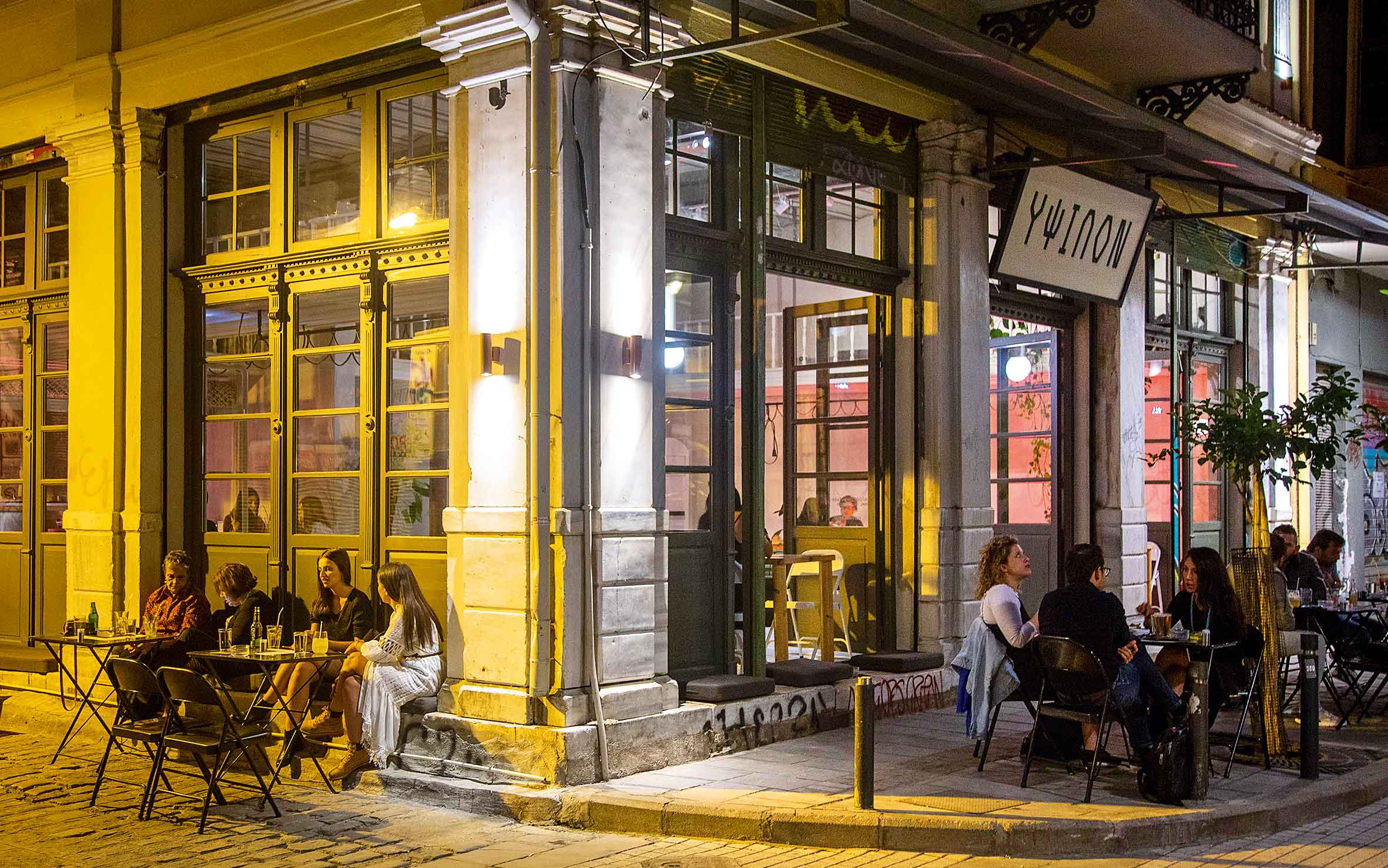
© Perikles Merakos
It only takes a long walk from its waterfront up to the picturesque district of Ano Poli, the oldest part of the city, to discover just how much Thessaloniki has to offer. You’ll spot Roman-era monuments, Byzantine churches, beautifully restored Eclectic-style buildings, little neighborhood shops, and shopping arcades that time seems to have forgotten, as well as shiny new coffee shops and luxury boutique hotels. Thessaloniki is ancient and modern, Eastern and Western, youthful and old-fashioned, sparkling and run-down, sleepy and restless, and full of creative energy that spawns new ideas. It might also be on the verge of becoming one of the most fascinating city-break destinations in Europe.
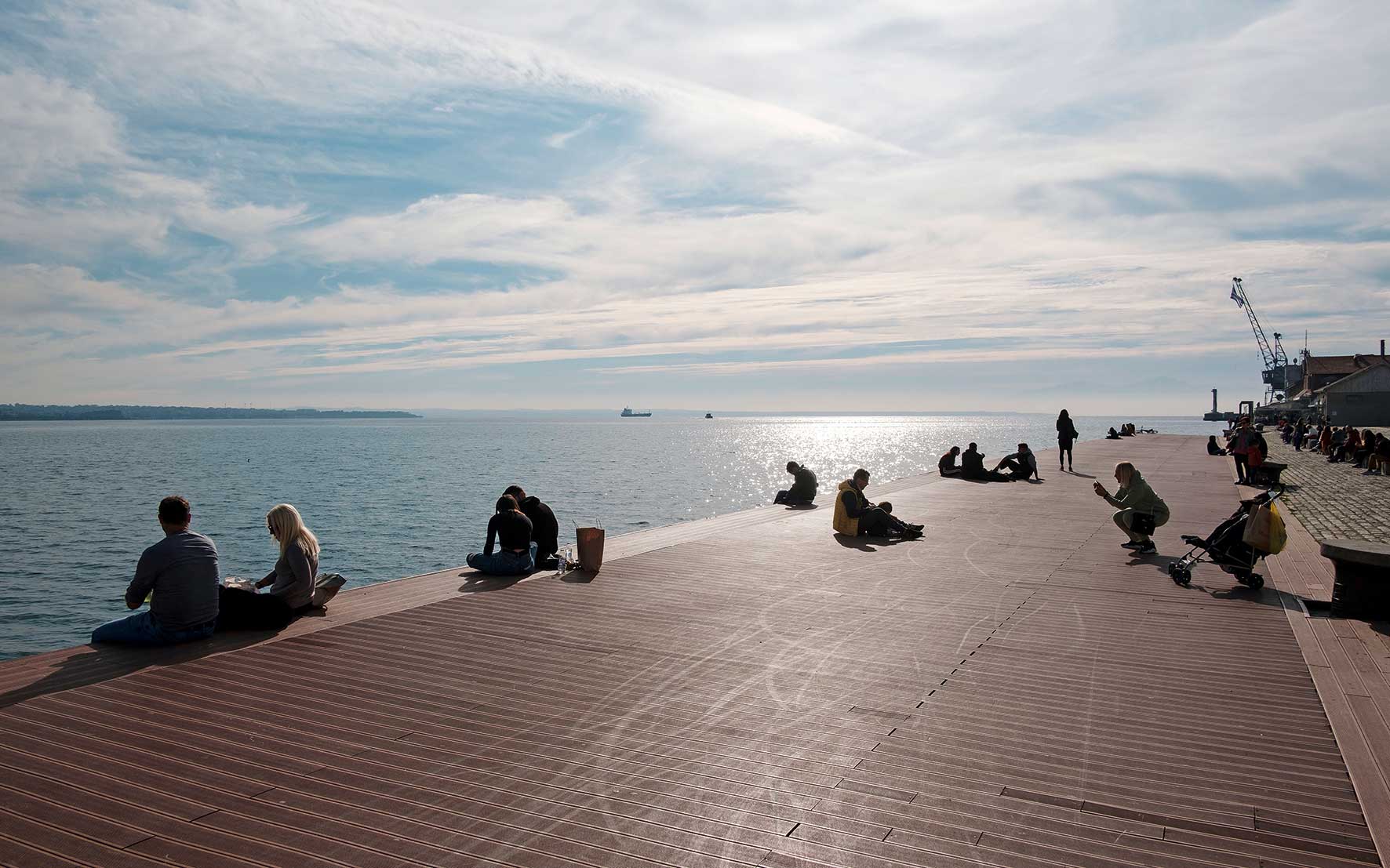
© Konstantinos Tsakalidis
A haven for culture
The old port has been reclaimed in recent years, with the areas closest to the center now hosting various cultural institutions. The restored warehouses opposite Eleftherias Square are venues for the renowned Thessaloniki International Film Festival, which takes place every November, and for the Thessaloniki Documentary Festival, which is held every March. Nearby is the Cinema Museum of Thessaloniki (Warehouse A, entrance €2, open: Mon-Tue 09:00-15:00, Wed-Fri 09:00-19:00), dedicated to the Greek film history and displaying everything from movie clips to posters and other memorabilia.
Next door, you’ll find the Museum of Photography (Warehouse A, entrance €3, open daily except Mon 11:00-19:00), boasting a collection of 90,000 photographs dating from the late 19th to the early 21st century. Its current exhibition, dedicated to the philhellene French-Swiss photographer Fred Boissonnas and running until February 12th, 2023, is one of the cultural highlights of the year for the city. Just across the dock, you’ll find MOMus – Experimental Center for the Arts (for info, see page 74), a home for many different innovative forms of artistic expression.
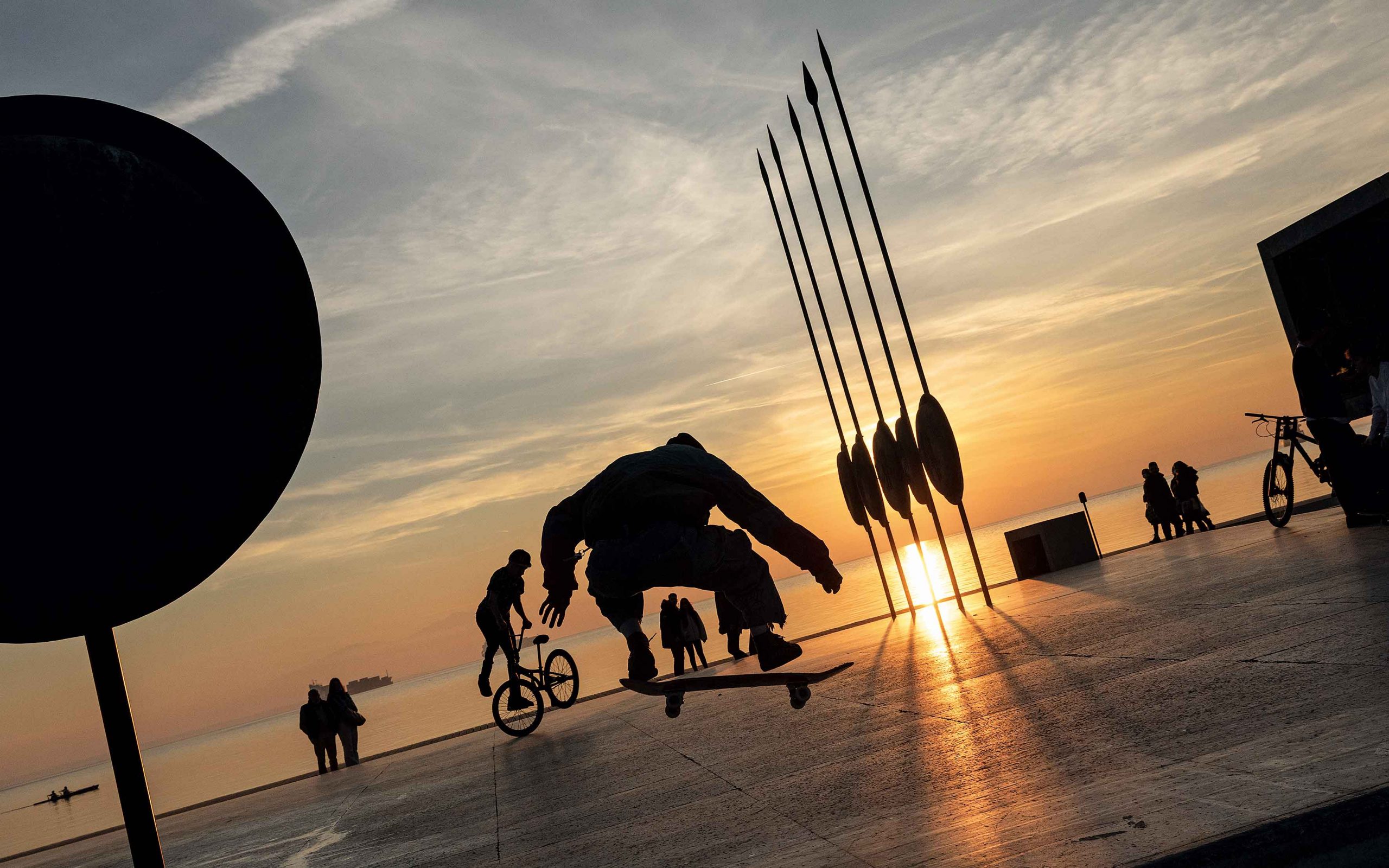
© Konstantinos Tsakalidis
At the water’s edge
The Nea Paralia (“New Waterfront”) is a three-kilometer waterfront promenade and one of the city’s most beloved outdoor spaces; it was a particularly popular destination during the COVID pandemic, when restaurants and other leisure and entertainment options were unavailable to the public. Running from the White Tower to the Concert Hall, it features thematic mini-parks, art installations such as the much-photographed Umbrellas by Yorgos Zongolopoulos, and many spots to rest and take in the view.
Morning and afternoon, this long walkway is flooded with people of all ages who come here to stretch their legs, ride bicycles or enjoy take-out coffee as they gaze across the Thermaic Gulf, hoping for a glimpse of Mt Olympus in the distance. If you don’t feel like walking, you can start your promenade experience from the Concert Hall, where Thessbike (thessbike.gr) operates a stand with all kinds of bikes for rent, including electric bicycles, two-person and three- person bikes, and even electric scooters.

© Nicolaos Tsakouridis
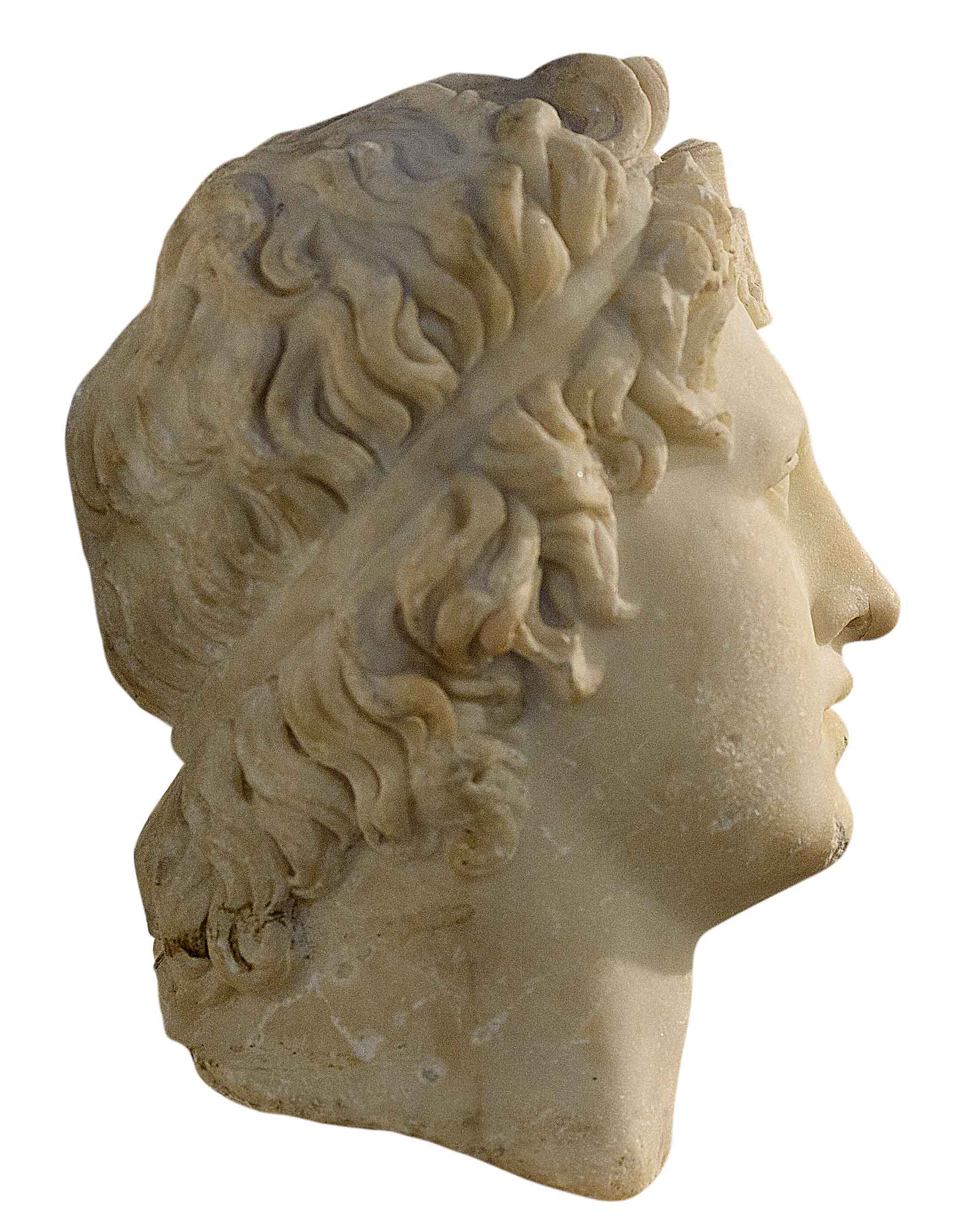
© N. TSIOKAS/COURTESY OF THE ARCHAEOLOGICAL MUSEUM OF THESSALONIKI
Journey through history
This year, there’s great reason to start exploring the city at the Archaeological Museum of Thessaloniki (6 Manoli Andronikou, amth.gr, entrance €4, open daily 8:30-15:30), as it celebrates its 60th anniversary with a thrilling exhibition chronicling the most important moments in the city’s history. What’s more, the museum building itself is a historical city landmark in its own right, a prime example of 1960s modernism designed by the distinguished architect Patroklos Karantinos.
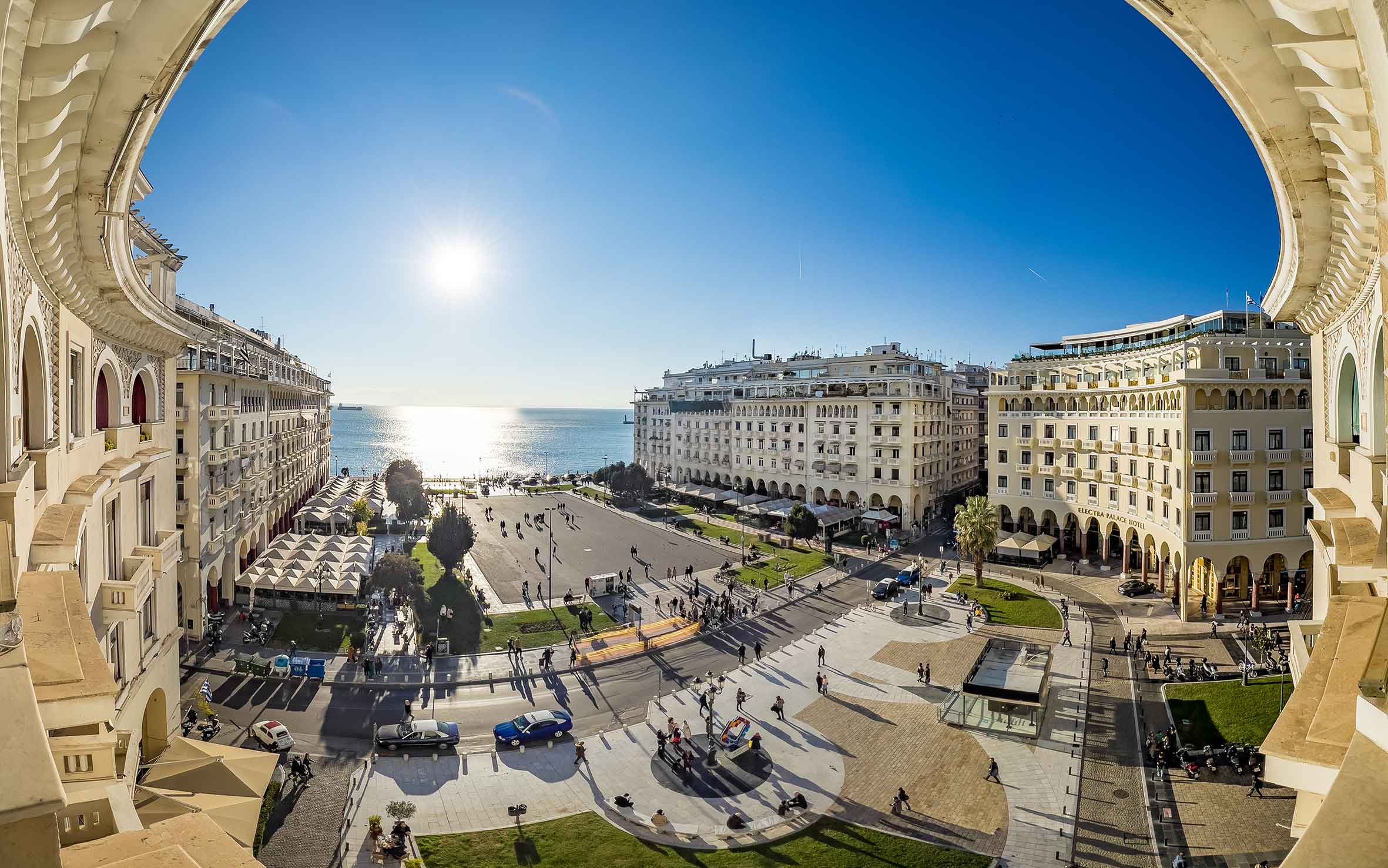
© Shutterstock
A square in the heart
In 1917, the center of Thessaloniki was ravaged by a terrible fire that burned almost a third of the city. Reconstruction began soon afterward, and the French architect Ernest Hebrard redesigned the city center. The centerpiece of his urban plan, implemented only in part, is Aristotelous Square and the pedestrianized street of the same name. The southwestern flank of the square ends just a few meters from the sea; Aristotelous Street runs from the opposite end of the square north to the Roman Agora.
On the square itself, you’ll find the Electra Palace Hotel and, facing it, the Cine Olympion, headquarters for the Thessaloniki International Film Festival. Both buildings feature cafés with views over the imposing square and the Thermaic Gulf.
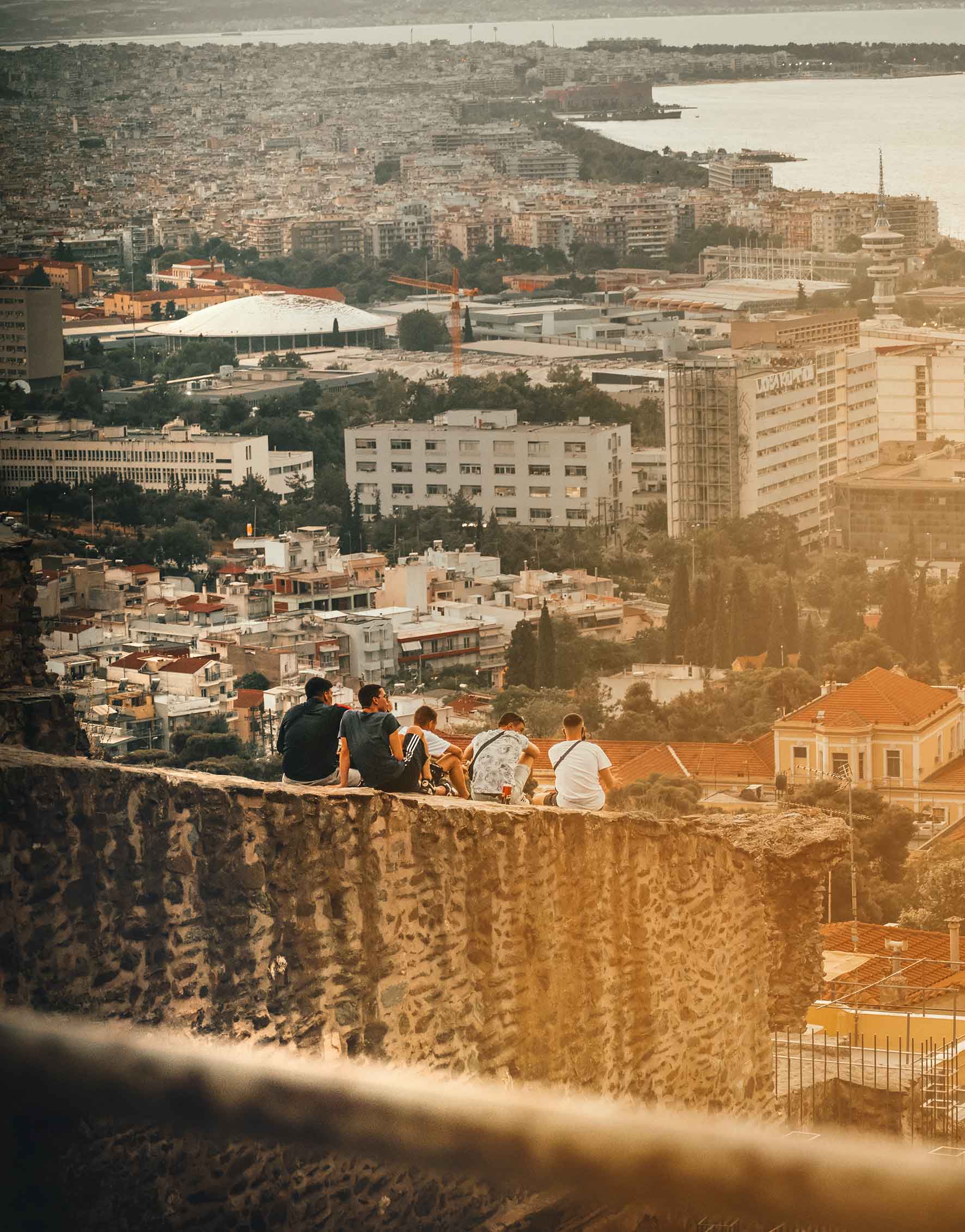
© Nicolaos Tsakouridis
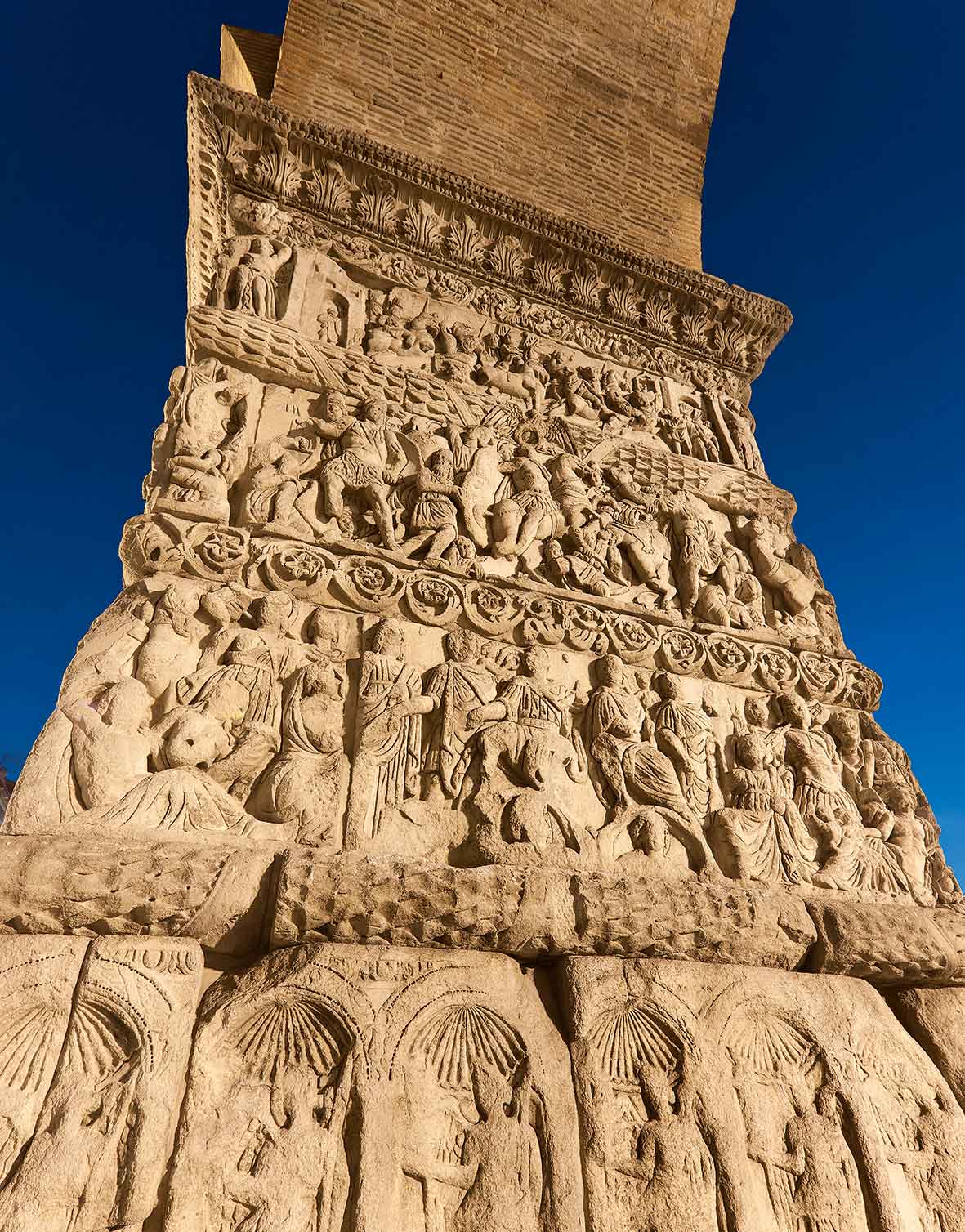
© SIME/VISUALHELLAS.GR
The city from above
The northernmost section of Thessaloniki is an elevated area called Ano Poli, or Upper Town; it’s one of the few areas to survive the horrific fire of 1917. Here you can still see buildings that predate that disaster, but in order to do so, you’ll have to climb a little. However, what you’ll discover here, along with the views of Thessaloniki that you’ll enjoy, will certainly be worth the effort.
Find your way to the Church of Aghios Dimitrios, dedicated to the city’s patron saint, and head uphill for 400 meters to Terpsitheas Square, where you’ll see an octagonal domed building, the mausoleum of Musa Baba, a Muslim saint of the Order of Bektashi Dervishes. A bit higher up lies Tsitsanis Square, with a statue of the famed musician Vasilis Tsitanis, and many traditional coffee shops and tavernas where you can catch your breath and enjoy a drink. You’re near the city’s great Byzantine walls, part of its medieval fortifications. Seek out the main gate, known as Portara, where Akropoleos Street runs into the old fortified district of Ano Poli, and then turn left for the restaurant Koukida sta Kastra (13 Agrafon), which serves outstanding fish and meat dishes.
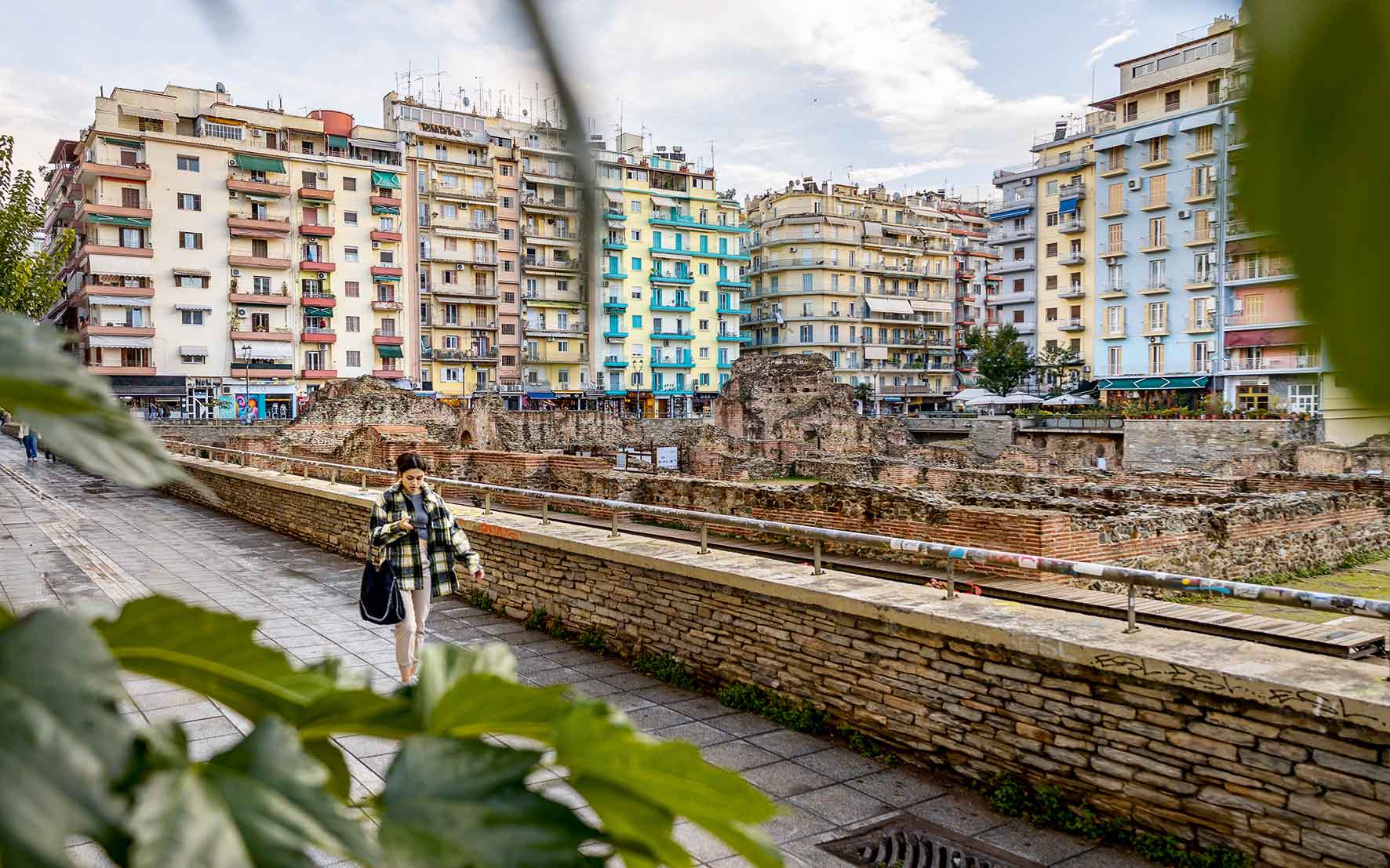
© Sakis Gioumpasis
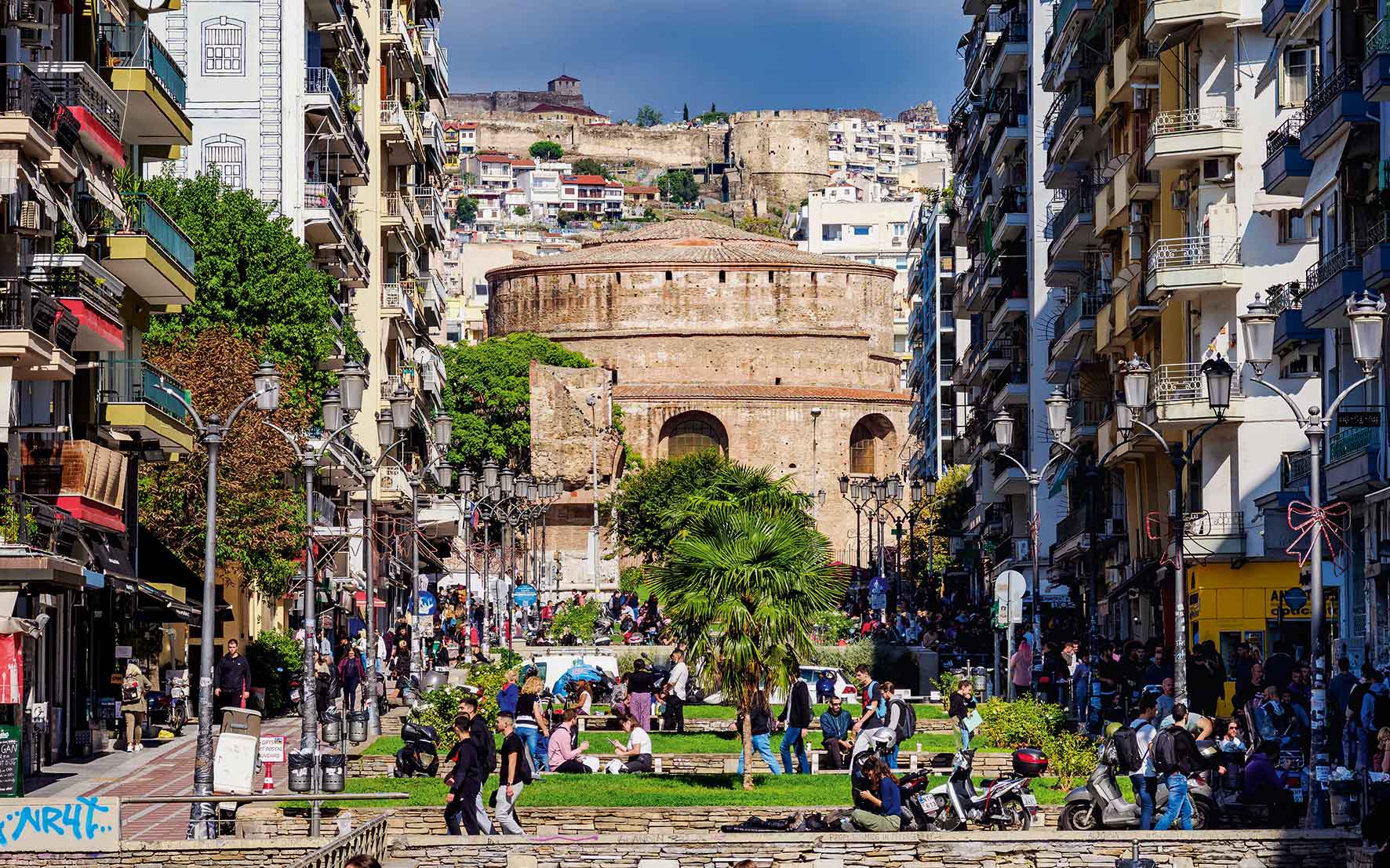
© AFP/VISUALHELLAS.GR
Historical walks
The other importand pedestrianized stretch of road in the city is Dimitriou Gounari Street, known by everyone as Navarinou, near the city’s two universities. Depending on the time of day, you’ll come across crowds of students heading for Navarinou’s bookstores, or picking up something to eat on the trot from the dozens of fast-food outlets that operate here.
One way to see this street is to start from the Arch of Galerius (also called the Kamara), or the Rotunda next to it. Halfway to the shore as you head south lies the Palace of Galerius. Together, these structures form the Galerian Complex, the most important group of monuments in the city. Construction began at the end of the 3rd century, when the Roman Emperor Galerius chose Thessaloniki as the seat of the eastern part of the Roman Empire. The Palace was the residence of the Emperor, the Kamara is the arch built by Galerius to commemorate his victory against the Persians, and it’s believed that the Rotunda was initially built as a church, mausoleum or throne room. Whatever its original purpose, this circular structure remains impressive.
Further south is recently renovated Fanarioton Square, with a statue dedicated to the women of Epirus who resisted the Germans during the Second World War. From here, it’s just a short walk to the Nea Paralia and the White Tower, the city’s most famous landmark.
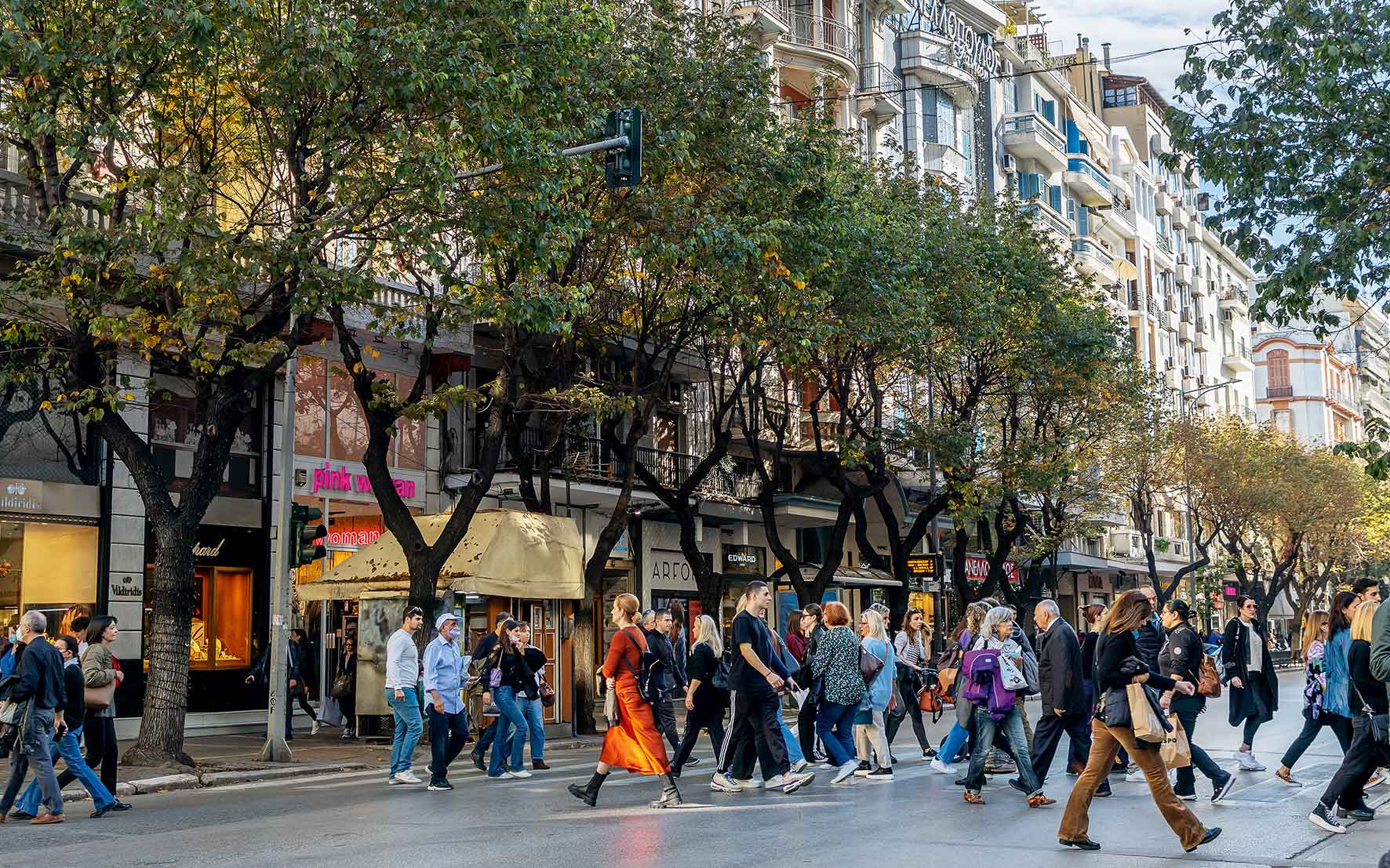
© Sakis Gioumpasis
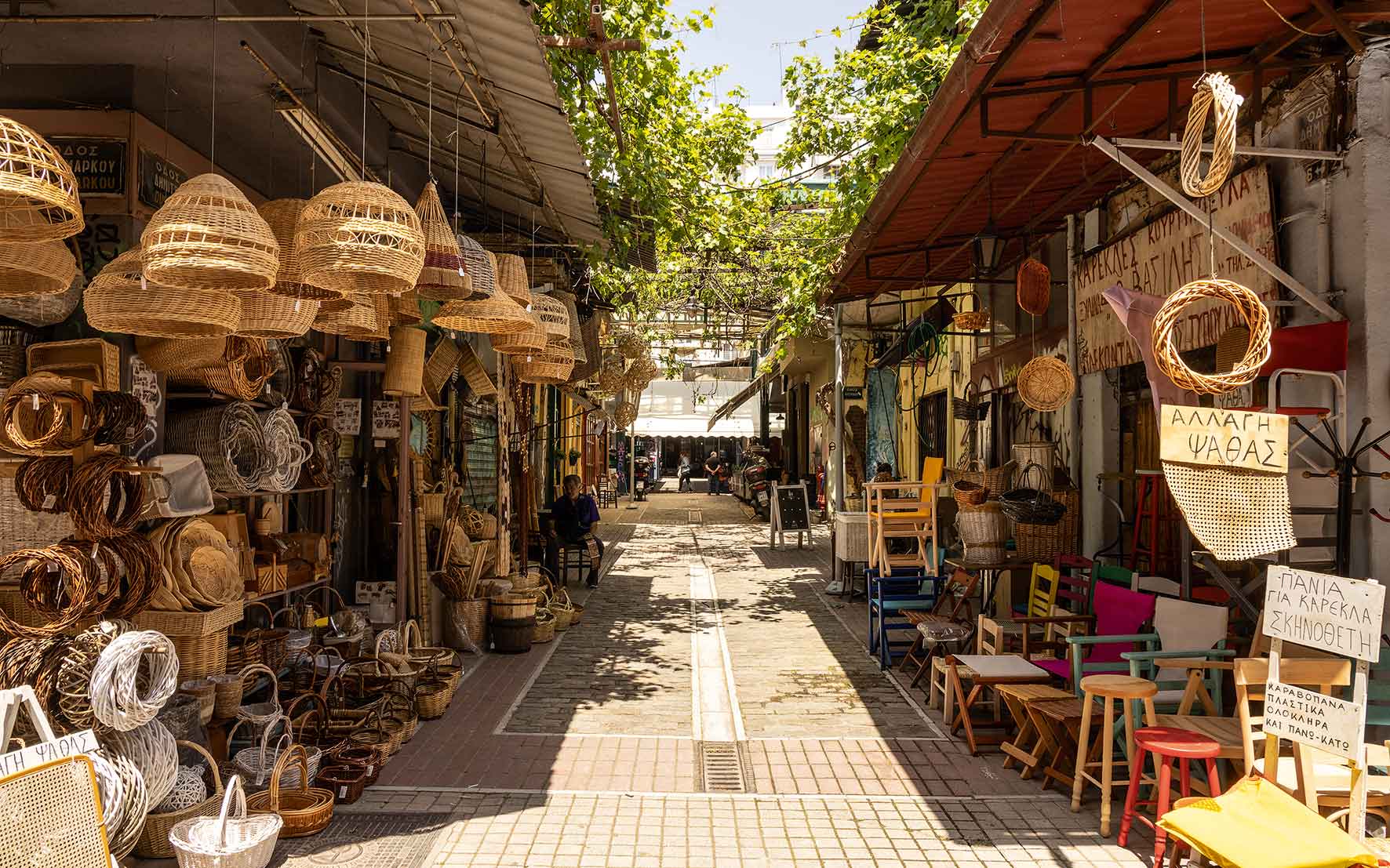
© Olga Deikou
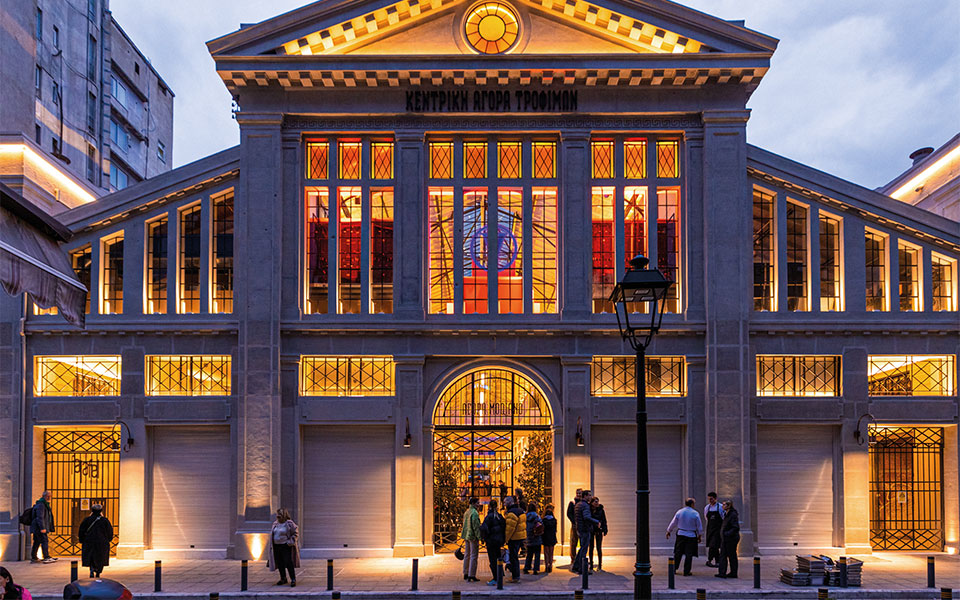
© Olga Deikou
In the markets of the world
Thessaloniki was once a center of trade, with merchants hawking wares from across the ancient world. Today, traces of this great past can still be found behind modern corporate buildings and down lanes running off wide avenues. On both sides of Aristotelous Street are alleyways and side streets where locals shop for their everyday needs, buying meat, nuts, spices, fruits, and vegetables from establishments little changed over the decades. This part of town is lively and loud, just as a living city should be.
Here the Kapani Market has been operating for more than two centuries; today, it offers everything from clothes and souvenirs to fish, olive oil and cheeses. The covered Modiano market, which lies south of Kapani, opened for the first time in 1930 and was declared a historic landmark in 1995. It recently reopened after years of disuse, and now, newly renovated, is home to almost 70 businesses, including both café-restaurants and grocery stores.
On the other side of Aristotelous Street is Athonos Square, with workplaces for carpenters, ironmongers, and locksmiths. You’ll also find small shops selling chairs, stools, and other wood items, as well as many stores selling foodstuffs. Harilaos (24 Vatikiotou) roasts and sells fresh nuts sourced from all over Greece, as it has for nearly half a century. There are many tavernas and restaurants in this area, too. Locals crowd the tables at Katsamaka which serves gyro, kokoretsi (lamb or goat intestines wrapped around seasoned offal) and kontosouvli (slow roasted pork on a skewer).
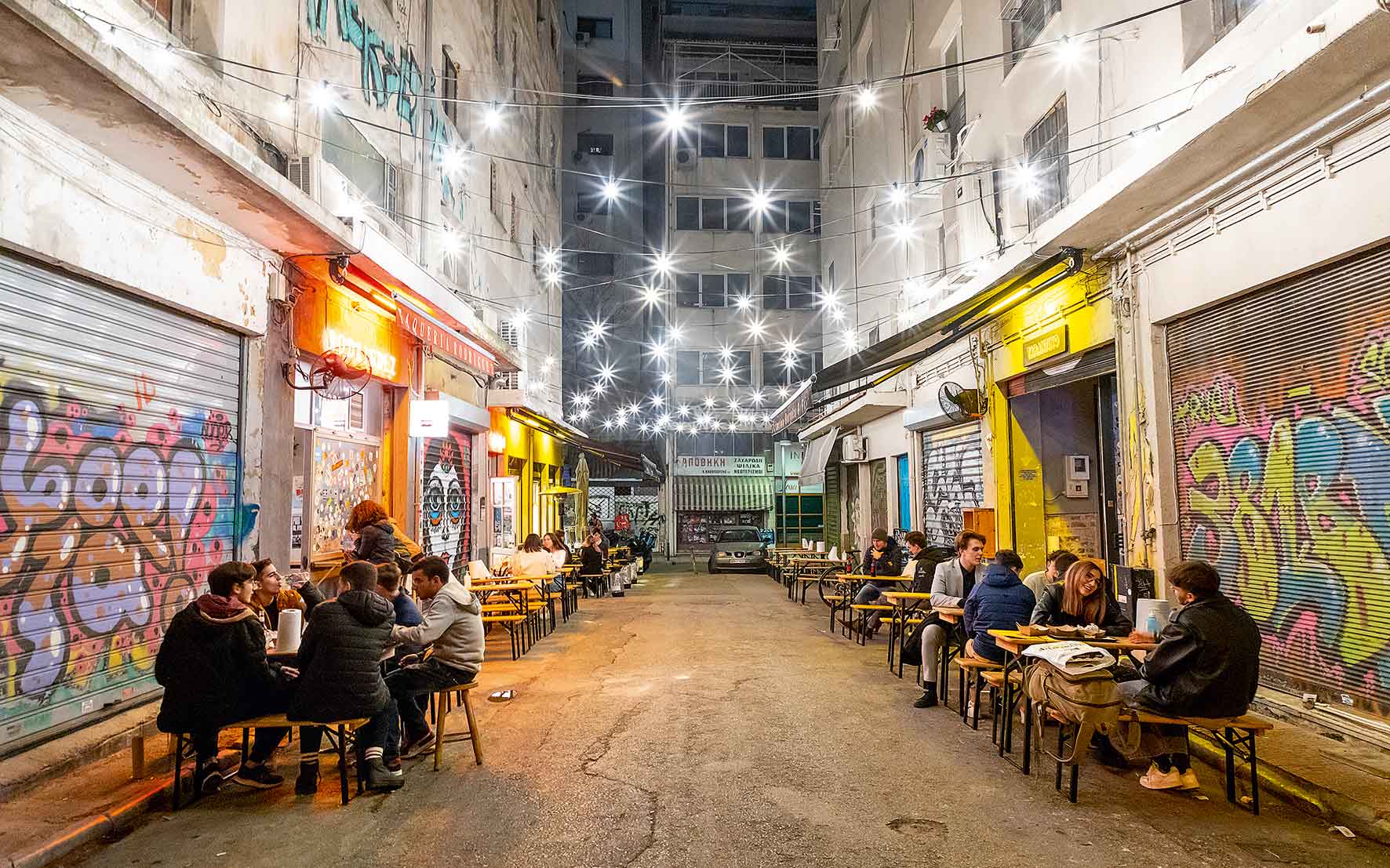
© Sakis Gioumpasis
Taste
Even Athenians will admit that Thessaloniki boasts an outstanding gastronomic scene, and everyone agrees that it’s easy to eat well here without going over budget. In addition to the rich culinary traditions of the many different ethnic groups that called the city home over the years, Thessaloniki’s gastronomic identity has recently benefited from the contributions of a number of creative young chefs. Here’s a quick look at just some of what the city has to offer.
Sebriko (2 Fragon) was one of the first places in Thessaloniki to explore beyond the city’s culinary roots, using traditional ingredients and creative cooking techniques. Here you’ll find a variety of Greek cheeses and many handmade mezes, such as smoked eggplant with yogurt, tahini and mint sauce, or savory pastourma mini pies with yogurt and quince jam. It also has a very good Greek wine list and a selection of beers from Greek microbreweries.
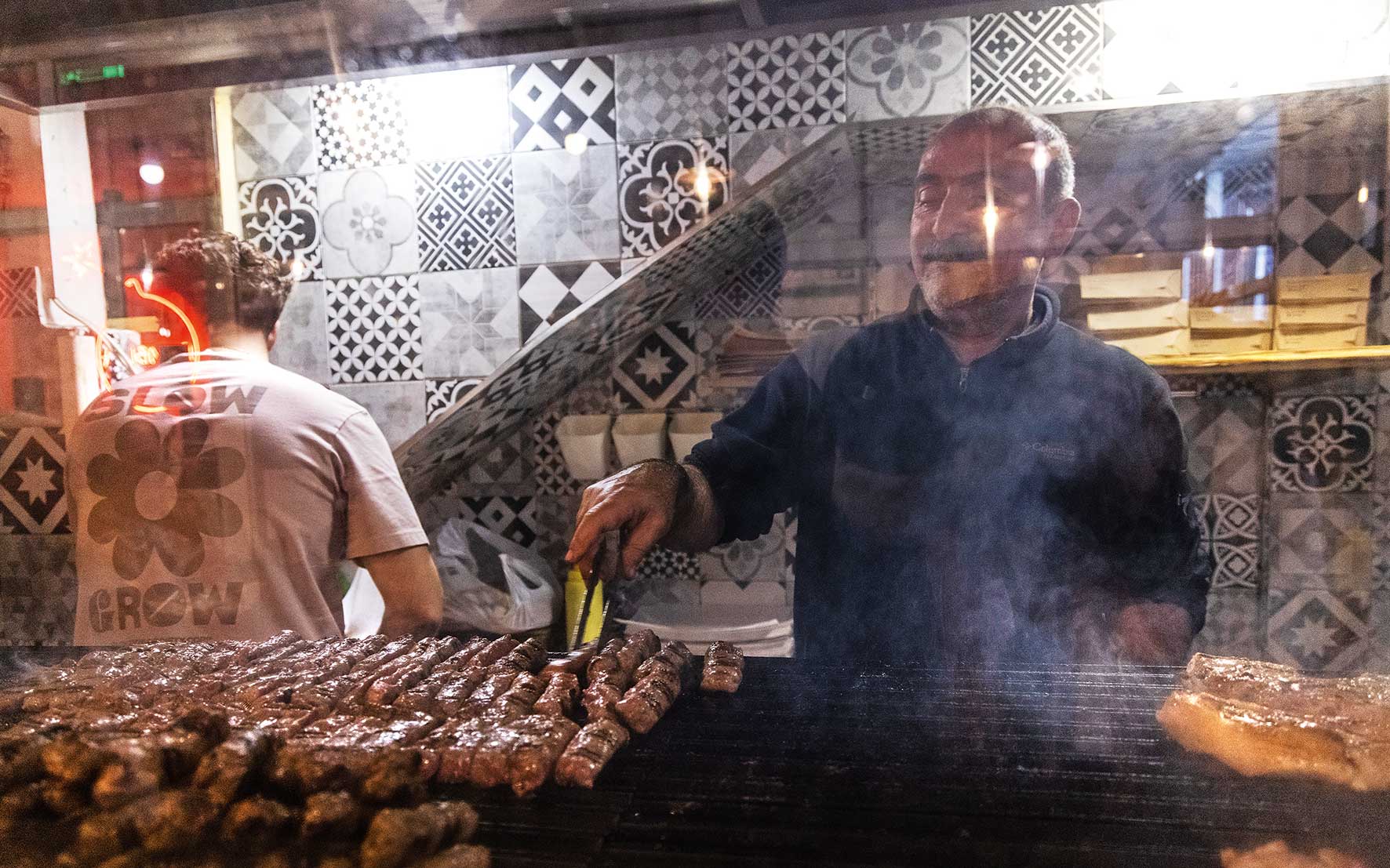
© Olga Deikou
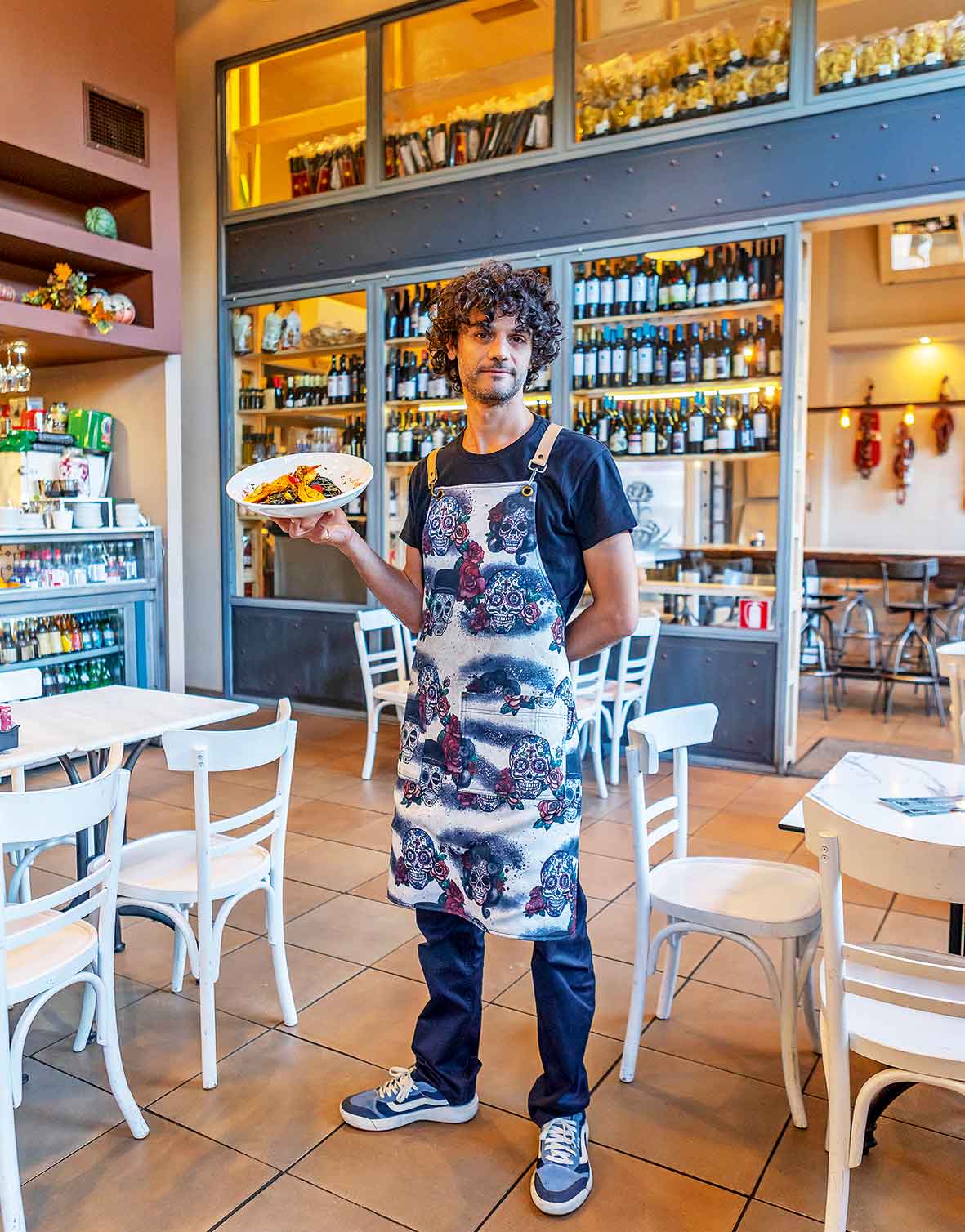
© Olga Deikou
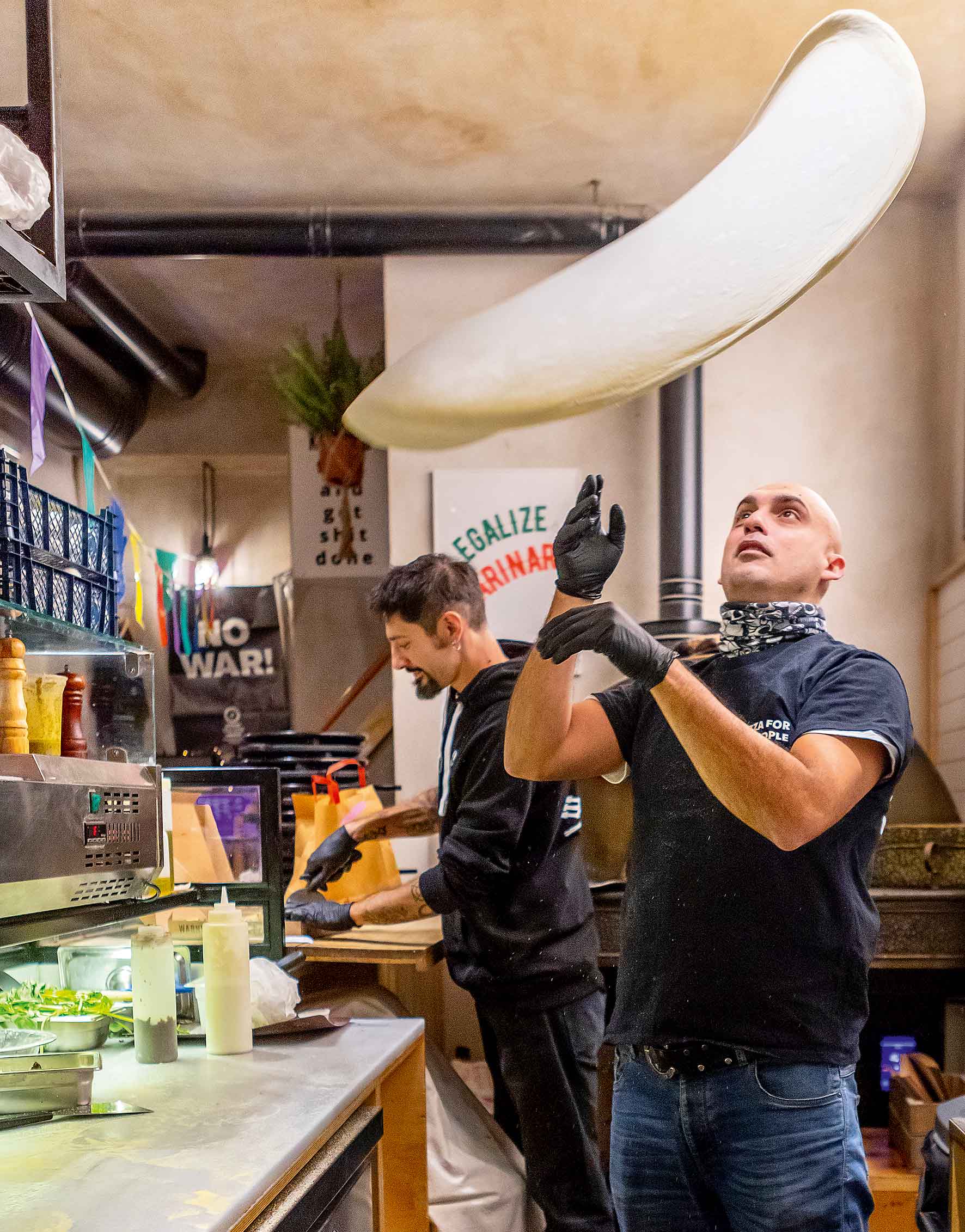
© Sakis Gioumpasis
Another representative of this new gastronomic culture is Sin Trofi (7 Doxis), where you’ll find a menu with dishes meant for sharing – the idea is that everyone tastes as many different flavors as possible, from the goat stew to the seafood tartares and ceviches made with a variety of fresh fish. The vegetables are mostly organic, and even the olive oil is special; an early-harvest extra virgin olive oil, served with hand-kneaded bread, is the first thing they serve you, and it’s so good you’ll ask for more. Try a version of the traditional braised rooster with pasta served with arseniko cheese from Naxos, or the black pork steak served with naan bread. It’s not all innovation, however, and there’s always room for the classics, too.
The signature Thessaloniki dish is soutzoukakia, oblong beef patties, made according to recipes brought here more than a century ago by refugees from Asia Minor. These wonderful meat treats are usually made from ground beef with some pork or lamb mixed in, and can be flavored with many different spices, with cumin a particular favorite.
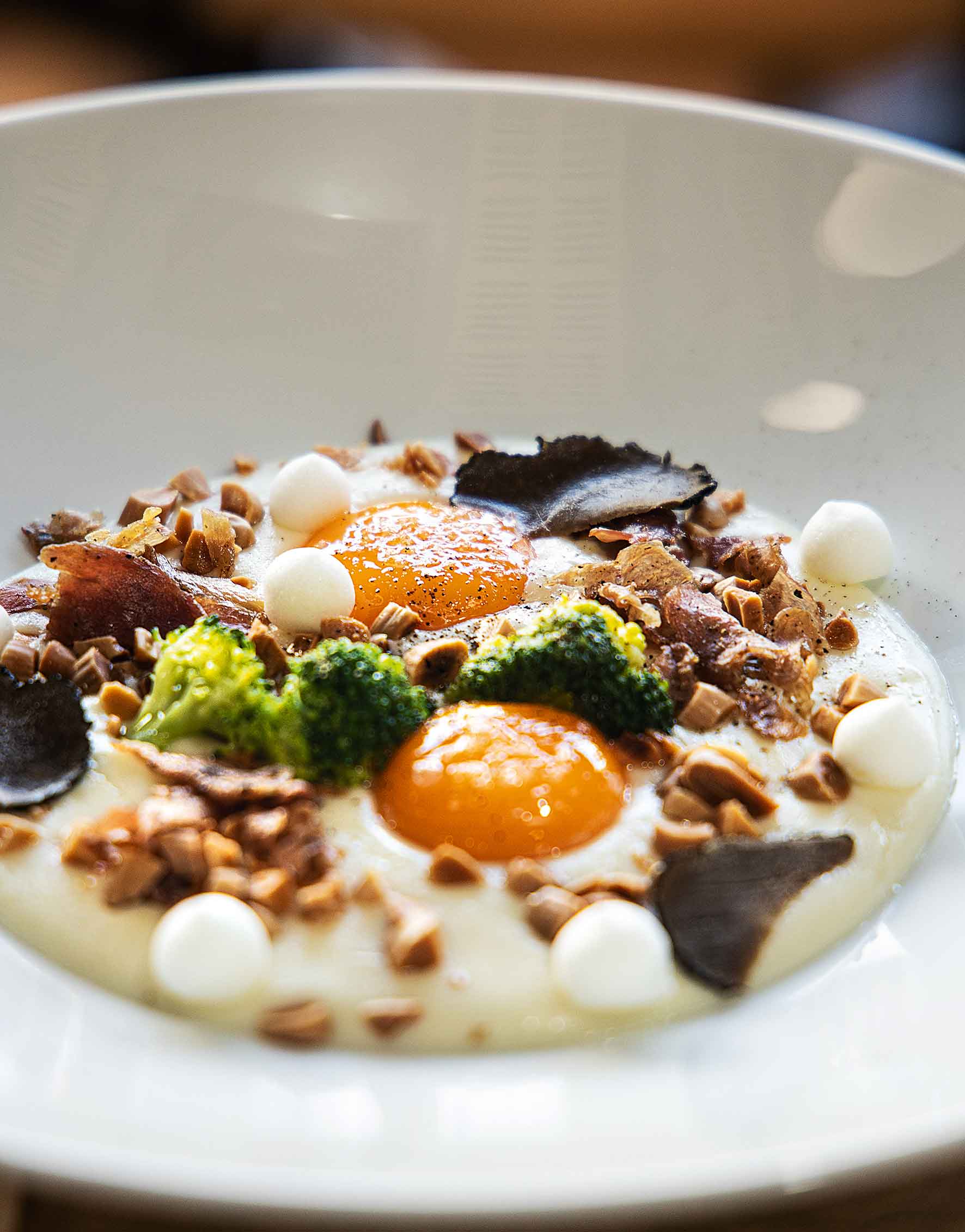
© Olga Deikou
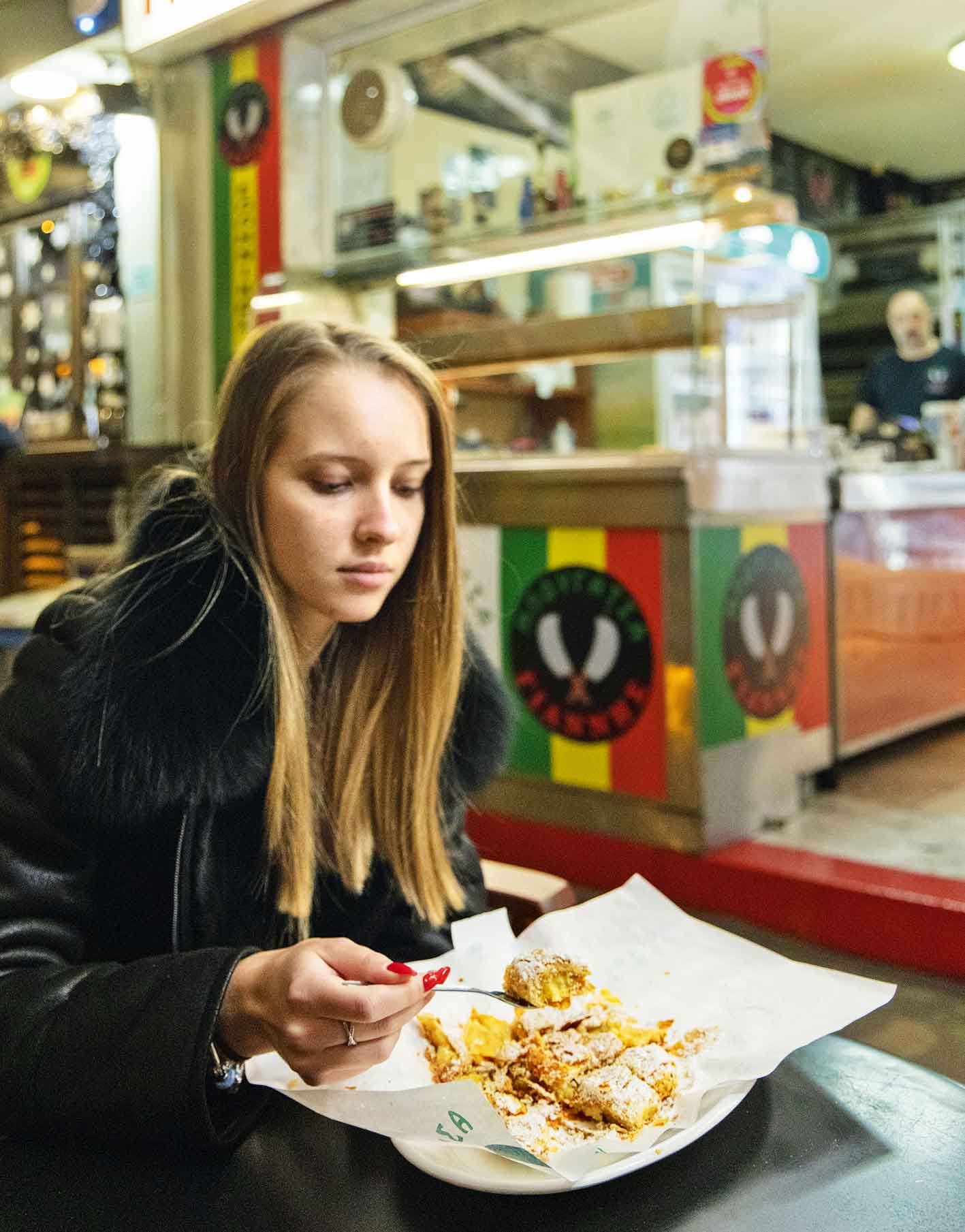
© Olga Deikou
You’ll find one of the city’s best versions at Vomvidia (35 Vasileos Irakleiou), where the patties are served on parchment paper with fries and warm bread. At Haroupi (4 Doxis), chef Manolis Papoutsakis draws inspiration from his home island of Crete and sources nearly all his ingredients from there to create delicious dishes. From his freshly baked sourdough bread to the traditional gamopilafo (traditional Cretan wedding rice) with hogget meat and goat milk yogurt, everything here is genuinely Cretan, even if it’s a few hundred kilometers from home.
Thessaloniki is heaven for those who love street food, too, with dozens of places offering their items to go. Had your fill of souvlaki? Try the great burgers and sandwiches at Tarantino (5 Ernestou Emprar), or cross the street for delicious thin crust pizza at Pizza Hood (2 Ernestou Emprar). For a great local version of bao buns, head to Thess Bao, in two different locations in the city center (3 Kalapothaki, 11 Lori Margariti). For brunch, try Caravan (1 Rebelou) and choose from a large variety of egg-based dishes, as well as a selection of sandwiches and pancakes.
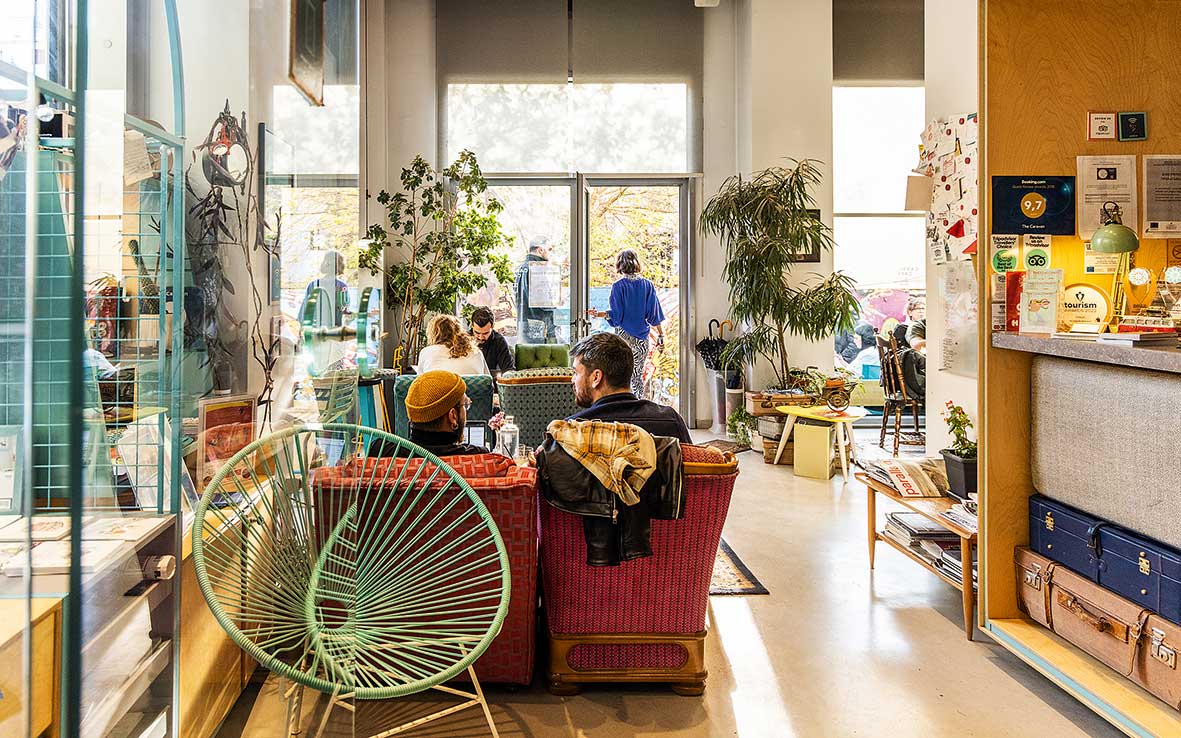
© Olga Deikou
The city is also known for its desserts; the bougatsa, perhaps its most famous one, is made with very thin filo pastry and custard cream, and served with powdered sugar and cinnamon. Giannis (106 Mitropoleos) specializes in them.The nearby pâtisserie Trigona Elenidi (13 Dimitriou Gounari) serves up a triangular dessert made with syrupy filo pastry and fluffy cream. For something more chocolate-based, Choureal (9 Paleon Patron Germanou) offers freshly made profiteroles “constructed” according to your preferences, with the choux pastry baked every few hours to ensure ultimate freshness.
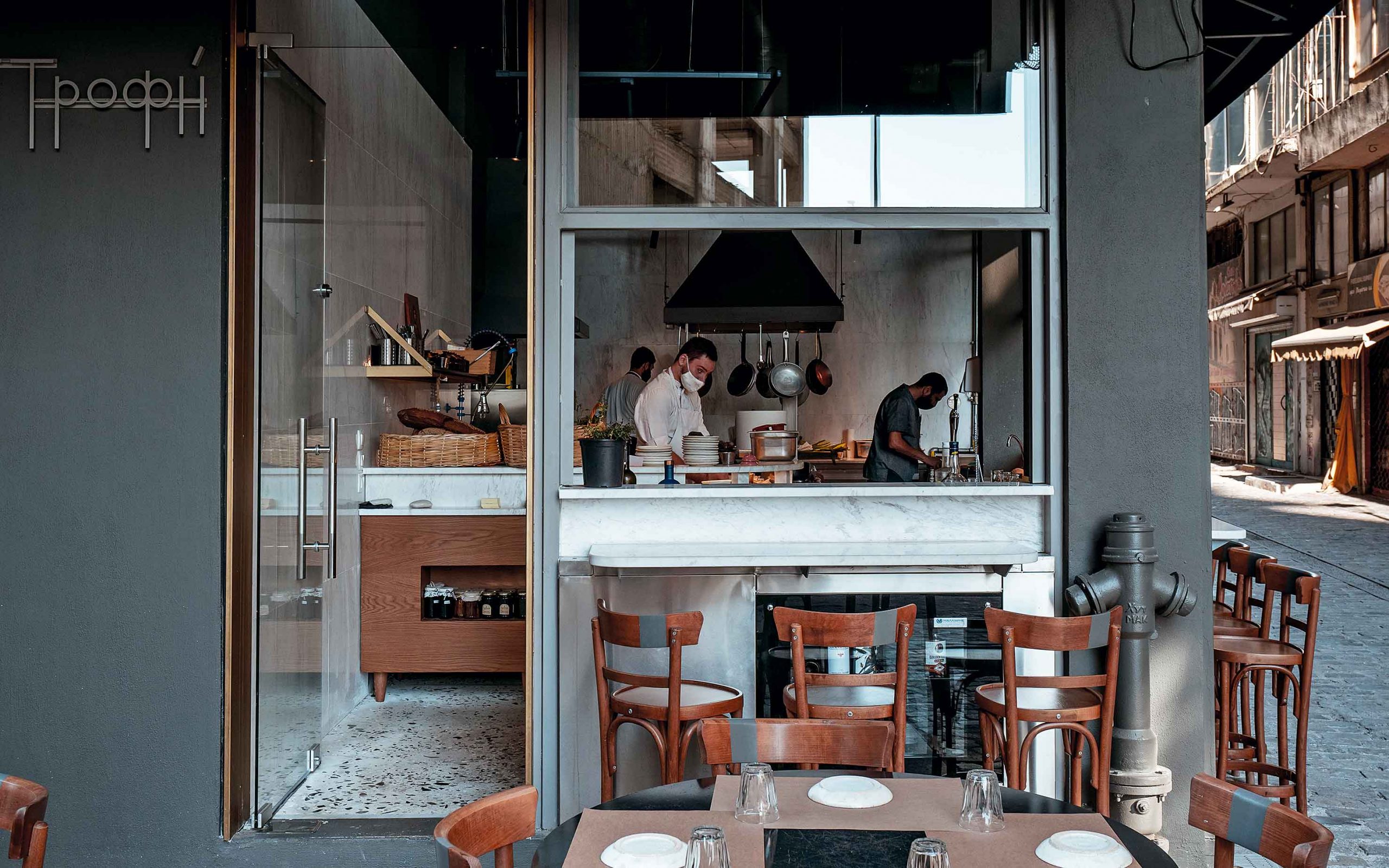
© Nikos Karanikolas
The residents of Thessaloniki have a well-earned reputation for enjoying a good time out throughout the year. The city is full of cafés with outdoor seating to take advantage of the many sunny days. Café Palermo (4 Romanou) is a Sunday-morning meeting point. Ypsilon (5 Edessis) is an all-day café that becomes a vibrant bar at night, hosting DJ parties.
For cocktails, head to Vogatsikou 3 (3 Vogatsikou), with its extremely well-stocked bar featuring almost every kind of rum, whiskey and gin imaginable. For beer, classic drinks and soul jazz music, head down the steps to On the Road (61 Nikis), a perfect hangout near the waterfront. At La Doze (1 Vilara), you can dance till dawn to electro music selected by well-known DJs, while at Enola (19 Valaoritou), the LGBTQ+ crowd turns it all the way up.












